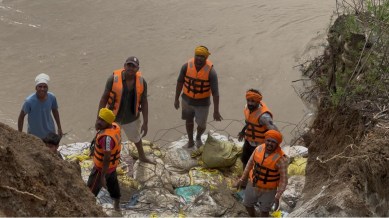Stay updated with the latest - Click here to follow us on Instagram
‘The river is at our door’: Waters threaten a village that thought it was flood-proof
A settlement that escaped the 1988 deluge now battles erosion as Sutlej-Beas swallows homes and fields

For the first time in living memory, Marrar, a tiny village near the Harike Headworks in Tarn Taran, is staring at a disaster it had only heard of in stories. The Sutlej-Beas river, which for decades stayed at a respectful distance, is now just a few steps away from homes. Villagers fear that their houses may collapse any moment.
Baljeet Kaur, whose home now clings to the edge of a collapsing riverbank, has not slept for 15 nights.
monthly limit of free stories.
with an Express account.
“The river used to be one and a half acres away. Now it is right next to our house. The administration keeps telling us to pack and leave, but we just want our home saved. The river has already taken our fields, now our house is under threat,” she said, her voice trembling.
Even during the devastating floods of 1988, Marrar was untouched. “This is the first time in my life we are facing this. Most of our land has already gone into the river. We grew wheat and mustard here, now only a sliver remains,” Kaur said, pointing to the eroding edge.
Marrar has fewer than 400 residents and overlooks the lush Harike Wildlife Sanctuary, a Ramsar-designated wetland of international importance. Its people had always believed they were safe, perched 25–30 feet above the riverbed. But that confidence is gone.
The first signs of erosion appeared around August 16–17. Residents say they repeatedly warned authorities, but official response was slow. “Officials came, made reports, and left. Nothing moved until religious volunteers stepped in. If Baljeet Kaur’s house can’t be saved, the rest of the village won’t survive either,” said Jagtar Singh, a farmer.
Urgent protection work is now underway.
“Three days ago, we observed that bank erosion had started near Marrar. Water discharge from Harike upstream was over two lakh cusecs, and the right bank began cutting toward the village. The population was barely 200 feet from the edge. We immediately started flood protection using wire crates filled with sandbags. Now, the water is just 20 feet from the village,” said Sahil Kumar, Executive Engineer, Tarn Taran.
The Water Resources Department is working with MGNREGA labour and local volunteers to finish the task in two days. But residents say it’s not enough. “We don’t need food or rations. We need soil and trolleys to strengthen the bank. We are ready to work day and night,” said Harmail Singh.
Three religious groups, including Baba Sukha Singh Sarhali and Baba Avtar Singh Bidhi Chand Tarna Dal volunteers, have joined the fight. “When the Babas came, they assured us we would be safe. Only then did real work begin,” said Kaur.
Gurpreet Singh Jatana, a volunteer, said more help is needed: “If we delay, erosion could reach the houses. We need more soil, more trolleys, more hands. The work has slowed because there aren’t enough people.”
According to engineers, this year’s flood levels were lower than 2023, but the river’s course shifted. “The sanctuary land on the opposite side is slightly higher, so the flow started hitting this bank directly. The waterway has narrowed, increasing pressure despite lower discharge,” Kumar explained.
Residents are pleading with the Punjab government to cut a diversion channel to push the river back. “We’ve been asking for a machine for 15 days. If the bend is cut, the village can be saved,” said Kaur.
Harike Wildlife Sanctuary, where the Beas and Sutlej meet, spans 86 sq km along the Amritsar border. Declared a sanctuary in 1999 and a Ramsar site in 1990, it hosts over 375 bird species, including 40 migratory ones that arrive from Siberia and the Arctic in winter. Around 45,000 ducks can be seen during the migratory season, along with pintails, shovelers, Brahminy ducks, and diving species like tufted ducks and pochards. The wetlands also shelter Indian otters, jungle cats, wild boars, seven turtle species, and 26 species of fish.
But this paradise for birdwatchers now forms the backdrop to Marrar’s struggle for survival.
For Marrar, the next few days will decide everything.